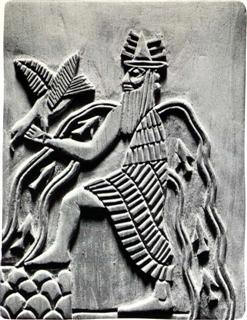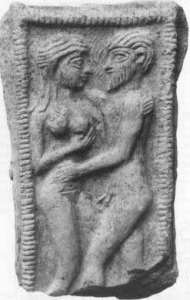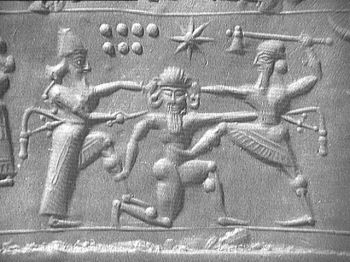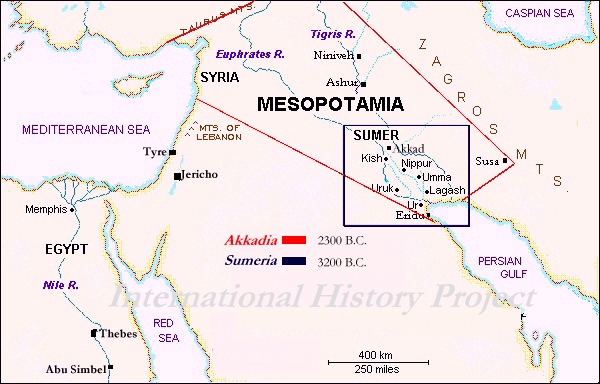Who are Gilgamesh and Enkidu
There are at least two levels or stories in this epos. There are the story about two human beings and their endeavors, and there is the story about mankind, where Enkidu symbolizes the sentient soul and Gilgamesh the Mind soul, the Ego.
On the personal plane we learn through Enkidu the descent into the physical plane and through Gilgamesh the ascent up from the physical plane.
I will here try to find the deeper aspects of these beings in the esoteric history of man, looking at them as persons and as symbols. The first part will mainly build on Rudolf Steiner’s “Occult History” lectures 1 and 2, concentrating on the persons of Gilgamesh and Enkidu, or Eabani as Steiner calls him. In the second part I will look at the events on the spiritual plane to show their symbolic nature.
From Occult History by Rudolf Steiner
In Occult History Rudolf Steiner tells:
These beings are the highest developed persons within the human wave, and already on the old Moon were they selected for their part in the development of Earth. We know them as the twelve Bodhisattvas, the seven Sages, and as Christian Saints.
In the start of the second lecture RS elaborates on this theme:
This is the definition of the Bodhisattvas and their helpers, who are guiding the human history through the recurring crises caused by the powers of resistance.
The Gilgamesh epic is a remarkable myth, describing the esoteric path as it is until our time and written as it was written for us.
The myth describes the development until the initiation, which first became possible later.
Who are Gilgamesh?
As the previous quote says, Gilgamesh is a being with enormous potential.
Now Gilgamish was a personality who had many incarnations behind him and may therefore be called an “old” soul within the evolution of humanity…The souls who came down early have therefore more incarnations behind them in earth-evolution than those who came down later; hence we can call these latter, in contrast to the former, “younger” souls — souls who have taken less into themselves…
In the case of Gilgamish, the Being who was to reveal himself through him, and who could do so only by leading him presently to a kind of initiation, kept a guiding hand upon him from the outset and set him at the place where he came to recognise his own position in the history of the world…
The whole nature of an old soul will enable it early in life to grasp not only the essential element, the essential factor, in the existing culture, but also that which strikes into it as a new impulse, opening up a wide vista into the future. [2]
Gilgamesh incarnated back in Lemuria, maybe as the first of the development wave of man. Through his many incarnation he had reached a stage about where man were at the time of the Maid of Orleans. 2 This is one of the reasons why RS uses the word personality about him, he has developed the Ego as no other person have at this time in history, he have lost all connections to the spiritual world, and is as Ahrimanic as a man can be, as the son of Adam, Cain. His task is to form the development of the Earth, he is the archetypal Hero.
It could be understood as nephesch (sentient soul) and ruach (mind soul) are full developed, but that n’schamah (consciousness soul) is not, two out of three.
 Gilgamesh – The Archetypal Hero
Gilgamesh – The Archetypal Hero
Who are Enkidu?
Enkidu (Eabani) is a diametrical different being; Enkidu is a being with few incarnation, ego-less and without karma, he lives in innocence with the animals. Through Enkidu’s encounter with a woman he acquires karma and becomes part of humanity, becomes part of civilization.
…
Eabani is depicted as being clothed in skins of animals. This is an indication of his wild nature; but because of this very wildness he is still endowed with ancient clairvoyance an the one hand, and an the other hand he is a young soul who has lived through far, far fewer incarnations than other souls who have reached a high level of development. Thus Gilgamish represents a being who was ready for initiation but was not able to attain it, for the journey to the West is the journey to an initiation that was not carried through to the end. [1]
In contrast to Gilgamesh, Enkidu is a young soul, without Ego, but with highly developed spiritual faculties, which Gilgamesh have lost. It can be said that Enkidu is the most Luciferic being born on Earth.
Enkidu’s task is to give Earth the Heavenly Wisdom to help man form the future. He is the archetypal Seer or Priest, as the son of Adam, Seth, the last born.
 Enkidu letting wisdom stream out over the world
Enkidu letting wisdom stream out over the world
Here we see Enkidu placed as a helper for Gilgamesh, where the Luciferic Enkidu should bring equilibrium with the Ahrimanian Gilgamesh, helping him to purify humanity.
Enkidu represent wisdom.
Gilgamesh and Enkidu
These two are born again and again through history, as the bringer of Wisdom and of Form, as Teacher and Hero, as Aristotle and Alexander, or Aquinas and Christian Rosenkreutz.
In the bible we see them showing the shift from the old clairvoyance to the knew, for example as Esau (red and hairy hunter) and Jacob, or as Solomon and Hiram Abiff [Temple Legend]
The spiritual strength of these two are shown through
These great ‘personalities’ incarnates each hundred years, as Steiner describes in connection with Christian Rosenkreutz and Master Jesus, and it’s naive to believe that these big human beings only have been incarnated the few times as some seems to believe. If you read the Occult History and look for the word ‘personality’ it will point to further incarnations of these persons.
From the Gilgamesh Epic
Steiner tells that this epic describes physical reflections of the spiritual, and that should be considered in the mentioning of Ahriman and Lucifer in the following. I try here to show the two companions relation to the Ahrimanian and Luciferic, to explain their physical roles described in the previous chapter.
Gilgamesh is described as a man with all knowledge, showing him as a highly developed human being, with full control of the physical world, a doer:
The text on the stone states that he is two third god and one third human, king and super human, but he oppresses his people harshly, uses his power egoistically for his own satisfaction.
 The people call out to the sky-god Anu, the chief god of the city, to help them. In response, Anu creates a wild man, Enkidu, out in the harsh and wild forests surrounding Gilgamesh’s lands. This brute, Enkidu, has the strength of dozens of wild animals; he is to serve as the subhuman rival to the superhuman Gilgamesh.A trapper’s son, while checking on traps in the forest, discovers Enkidu running naked with the wild animals; he rushes to his father with the news. The father advises him to go into the city and take one of the temple harlots, Shamhat, with him to the forest; when she sees Enkidu, she is to offer herself sexually to the wild man. If he submits to her, the trapper says, he will lose his strength and his wildness.
The people call out to the sky-god Anu, the chief god of the city, to help them. In response, Anu creates a wild man, Enkidu, out in the harsh and wild forests surrounding Gilgamesh’s lands. This brute, Enkidu, has the strength of dozens of wild animals; he is to serve as the subhuman rival to the superhuman Gilgamesh.A trapper’s son, while checking on traps in the forest, discovers Enkidu running naked with the wild animals; he rushes to his father with the news. The father advises him to go into the city and take one of the temple harlots, Shamhat, with him to the forest; when she sees Enkidu, she is to offer herself sexually to the wild man. If he submits to her, the trapper says, he will lose his strength and his wildness.
Shamhat meets Enkidu at the watering-hole where all the wild animals gather; she offers herself to him and he submits, instantly losing his strength and wildness, but he gains understanding and knowledge. He laments for his lost state, but the harlot offers to take him into the city where all the joys of civilization shine in their resplendence; she offers to show him Gilgamesh, the only man worthy of Enkidu’s friendship. [3]
Here Enkidu incarnates to be the helper and companion of Gilgamesh. He is shown in his pre-human state running wild with the animals, and how he becomes human through creating karma, through lust for living.
The woman Shamhats power is thinking and forming where Enkidu lived in wisdom. Six dayes and seven nights hints at the seven chakras who are prepared for the life on Earth.
He is like a good now, he have become a sentient being, conscious of his own I. He wants to rule over Gilgamesh, but the courtesan told him that Gilgamesh, the Ego, the mind soul, was stronger than Enkidu, the sentient soul. These two soul-bodies are joined together, and even to this day they fight each other, only the day that they don’t fight each other, are they released.
 Separation of the sexes – Twin Soul Aspects – Dual’s
Separation of the sexes – Twin Soul Aspects – Dual’s
He enters the Earth fully:
Cooked food, bread, and wine all weight the physical body down, binding the etheric body to the physical body.
 Enki. About 2,500 BCE. Note the image of planets revolving around the Sun!
Enki. About 2,500 BCE. Note the image of planets revolving around the Sun!
The sentient soul were the connection to the spiritual world, and wisdom, at that time. Here we also see the descent into the physical.
Here Enkidu gave tribute to Gilgamesh, representing the mind soul. The next tells about the sacred marriage between the sentient and mind soul, or the etheric and physical body:
The language of Gilgamesh, from his prophetic dreams (“I loved [Enkidu] and embraced [him] as a wife”) to the bridal bed in Uruk — Enkidu’s in retrospect — clearly refers to a “sacred marriage“: the spiritual union or blending of the inner and outer man. None of the extant material names a victor, but the Old Babylonian story given above suggests that the initial strife or “wrestling” is brought to an abrupt end by mutual recognition: Gilgamesh “bent his knees” (to Enkidu’s stature) and “planted his foot in the ground.” Both phrases are apparent wordplays on Enkidu’s name, indicating a successful (or “victorious”) bonding and assimilation. Enkidu’s subsequent acknowledgment and friendly embrace with Gilgamesh confirm their acceptance of the relationship.Up to this point the story has been prologue — an allegory about the evolution and creation both of mankind and of a truly human individual. From here on Gilgamesh and Enkidu go as one, faithful to each other until death. In the Sumerian stories, Enkidu remains the servant of Gilgamesh; in the Babylonian version, Gilgamesh’s mother adopts Enkidu — he becomes not only the servant, companion, and friend of Gilgamesh, but also his younger “brother.” Viewed as a single composite character, Gilgamesh-Enkidu represents the conjoining of heaven and earth, of spirit, soul(s), and body, in a full sevenfold partnership (5) necessary for one to succeed in the hero’s quest. [4]
The one tells that the sentient soul (Enkidu) is below (sevant of) the mind soul (Gilgamish), where he is a younger brother in the other tradition.
With Humbaba the terrible we are in Eden and he is known by Enkidu, which means they are related, and he guards the trees of wisdom and life. Enkidu, representing the Luciferic wisdom, is not ready to fight the Ahrimanic spirits, so he works against Gilgamesh.
This is part of the life of man, going through the twelve signs of the Zodiac:
 Gilgamesh and Enkidu with Humbaba
Gilgamesh and Enkidu with Humbaba
…
As Gilgamesh and Enkidu approached the forest, their trepidation grew. Shamash sent a message from the sky: “Humbaba has removed six of his seven cloaks. … They saw the height of the Great Cedar. Where Humbaba walked, a path was made. The road was good… [4]
The seven is connected to the chakras, and the seven-terrored was the chakras to clean. The path is the path of Karma.
On the six days travel (and seven nights?) Enkidu interprets the dreams of Gilgamesh, demonstrating that he is closer to the spiritual world. On the entrance to the Cedar Forrest:
Gilgamesh wins over Lucifer/Enkidu and they work together against Ahriman.
Here the Ahrimanic Humbaba tries to split the two, but Enkidu now inspires Gilgamesh with courage. When man has won his fight with Lucifer, he works as helper for man, as a holy spirit.
Here again Enkidu/Lucifer helps Gilgamesh against the Ahrimanic, which on it’s side bans the Luciferic from the physical plane. Enkidu dies, separates man from the spiritual, which introduces death, as man no longer remember his previous lives. The Sentient soul looses it’s sight into the spiritual world, the end of the old clairvoyance.
 Shamash (the Sun) between Mashu’s Twin Peaks,
Shamash (the Sun) between Mashu’s Twin Peaks,
Akkadian, 3rd millennium BC (British Museum)
He now starts his journey on the pure physical plane incarnating through the twelve star signs:
 Ziggurat in the Eanna Sector at Uruk (Andre Parrot, Sumer)
Ziggurat in the Eanna Sector at Uruk (Andre Parrot, Sumer)
References
1. Rudolf Steiner: Occult History, Lecture 1;
2. Rudolf Steiner Occult History, Lecture 2;
3. Richard Hooker Mesopotamia Gilgamesh Summary, Washington State University;
4. W. T. S. Thackara The Epic of Gilgamesh: A Spiritual Biography
Full text of Gilgamesh Epic, Gilgameš, Enkidu and the nether world.
- The Temple Legend by Rudolf Steiner
- The Masonic Legend by Max Heindel
- The Hiramic Legend by Manly P. Hall
Use back-button to go back to text!
Map


![kimgraaemunch [] GMail () com](https://kimgraaemunch.files.wordpress.com/2017/02/kimgraaemunch-g.png?w=210)













#1 by Suzanne Radford on August 23, 2010 - 12:54 am
Greeting,
I posted a link to your incredible site on our links page http://www.gnostics.com/gnosticschool.html
Thanks for the great work.
Regards,
Suzanne Radford
The Gnostic Pagan Project
http://www.gnostics.com
LikeLike
#2 by Kim Graae Munch on August 29, 2010 - 10:51 am
Thank you Suzanne, I appreciate your encouragement.
Regards,
Kim
LikeLike
#3 by Eunice Pinheiro on February 6, 2011 - 1:50 pm
When I first read this Myth it fascinated me…After a time I saw it on stage, a very powerful performance indeed which very much impressed me…
It is indeed a very architypal “story” and your writings about it are very enlightning!
LikeLike
#4 by Kim Graae Munch on February 6, 2011 - 4:19 pm
Thank you Eunice.
It is a fascinating story, and there is no feeling of age even though it’s the oldest scripture on Earth.
LikeLike
#5 by rileybrad on December 22, 2011 - 7:03 pm
Have been to UR and URUK in specific and Iraq and Baghdad before insanity and War broke out. A Ziggurat was an astonishing outdoor temple with the planetary systems forming layer upon layer to seven levels. At the top of the Ziggurat was a penthouse suit where Gilgamesh had first dibs on whatever wife and that the constellations and birth alignments were very much studied. The origin of our 7-layered wedding cakes with the married couple on the top come from the mystery of the ziggurat and the planets, which has all been but forgotten. Screen play on this subject, attempted by me a long time ago. http://tinyurl.com/cygpn9z
LikeLike
#6 by Thomas Gilmore on September 14, 2013 - 4:46 am
The Major Arcana of the Tarot are primarily alphabet cards (the number on the card gives the order of the 22 Hebrew letters on the cards).
It also has remnants of the illustrations of the 22 steps (chapters) of the myth of Gilgamesh. The Gilgamesh Tarot by T Byron G explores this thesis. The card decks and companion book are still available at geocubic.com
LikeLike
#7 by SID JEFFERIES on July 28, 2014 - 9:05 pm
Hi Kim,
I like your site. I’m also researching the Tree of Life history and connections with its astrology and Kabbalah aspects.
I would like to know the source reference for the wonderful cylinder seal with the planets around the Sun. I have images of many cylinder seals but none quite so telling as this and I would like maybe to use it if I can reference a source.
Many thanks,
Sid Jefferies
LikeLike
#8 by Beyond Enigma on February 7, 2020 - 4:43 am
It’s pretty tough to decipher what’s allegory and what’s not. I personally don’t think that the story is purely allegorical. I think the rest falls in line with prophetic dreams and astrotheology. David talbot has done wonderful work on this. He’s got so much empirical proof especially the formations of craters through electromagnetic storms (which has been tested and the markings are exactly the same as the ones on the moon, and other planets) and theories of cosmological migration. A theory that we were part of Saturn’s orbit at one time. Strong evidence for this. It’s possible we were a moon. Titan shows this evidence as well. One of saturn’s moons. They call it baby earth.
LikeLike